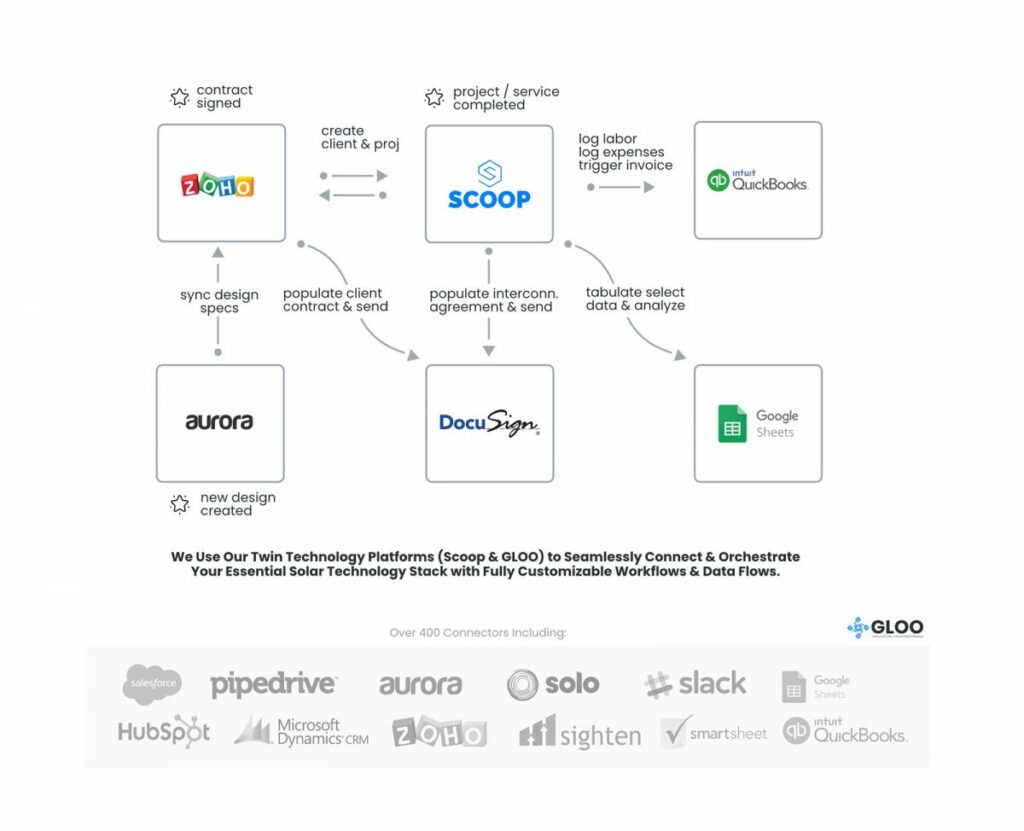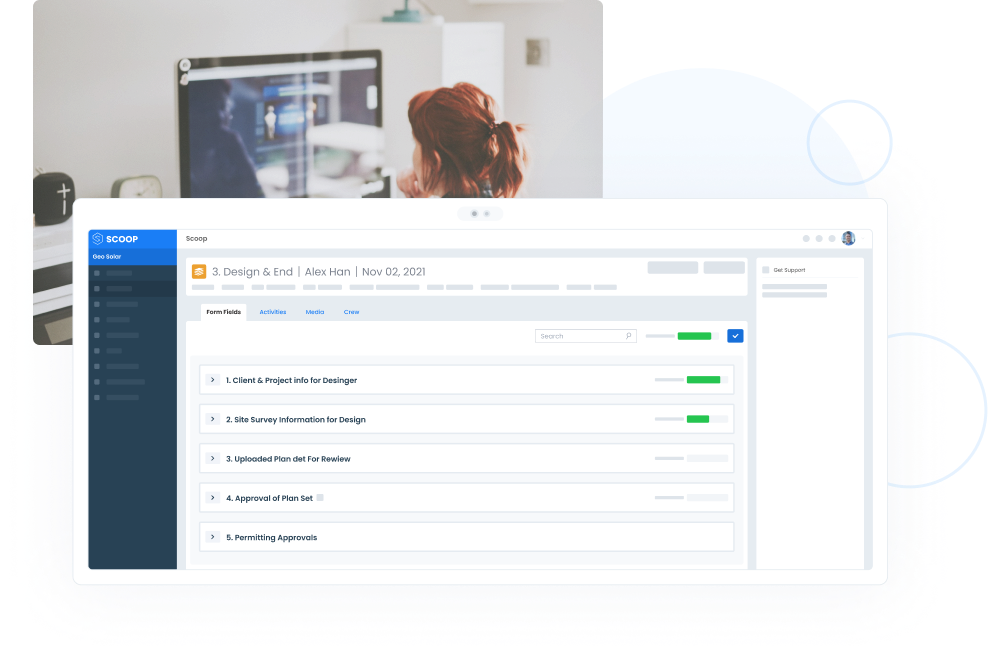What happens when your systems aren’t connected?
You lose 9 hours…per project.
This is the amount of time our solar residential installer customers tell us their teams are spending on manual, redundant, duplicate data entry tasks per installation project, per month. For our O&M customers, this number is typically 1-2 hours, per service or preventative maintenance work order.
Do any of the following tasks sound familiar for the folks on your office team?
- Manually entering the information that already lives in your CRM into your Design & Proposal generation tool or vice versa?
- Subsequently having to manually re-upload the final design, proposal and contract to a CRM or online file folder?
- Manually re-entering this same customer information from your CRM to your PM tool at project kickoff?
- Someone on your team taking the information captured throughout the project and manually filling out the same Net Meter Application, various Utility & JHA docs and PTO?
- Your team having to collect and re-enter your parts list between when it was developed and when the inventory shows up on site?
- Finally, after entering the project once in your CRM, twice in your PM tool (and possibly creating a few file folders along the way), having to manually create the Customer Record in your accounting tool?
- For those using a disconnected time tracking tool, likely having to then add those time cards to the accounting records before manually processing the invoice?
- Having to repeat the above multiple times, with multiple updates and round trips throughout the project?
As you look at the list above, you can start to see how this process (many steps are also required for every service ticket), could take 8-10 hours per project. If you’re executing 20+ projects a month, that’s nearly 200 hours, or $6,000 of labor costs (at $30/hour for mostly office time) that could be easily saved. But what’s even more significant is the opportunity cost your team could get back if they could dedicate those 200 hours to actually propelling your business forward.
So, why aren’t your systems connected?
There are 3 critical factors we see contributing to the lack of integration that causes Residential & Commercial Solar Installers & Service Providers to stall in terms of the growth and effectiveness of their solar operations:
- Tools at One Size Break During Growth: As fast growing installers & O&M providers grow, they patch together a mix of very niched tools (think messaging apps, file folders, time tracking tools, legacy office PM tools, paper & pencil) across field and office. These tools may be financially reasonable and quick to start at first, but they are not designed for detailed industrial field work and often do not offer the sophisticated integration capabilities to meaningfully connect workflows with other niched tools.
- The Myth of “One System to Do it All”: Once installers reach a certain size, they may be looking for “One IT Tool to do Every Job”. We believe that these monolithic tools are a thing of the past and in addition to the sub-par, watered down features that only work across a fraction of advertised capabilities, they charge exuberant fees and hidden costs to access their API (for integrations) as a ploy to force customers to use their native but less-than-capable native features, essentially holding customers captive.
- Sub-par 3rd Party Integration Tools: Some installers who are further ahead in building their technology stack will opt for an entry level or consumer grade integration tool. Typically these tools begin only to scratch the surface of solving the manual, time consuming tasks that are taking place across the organization – but these 3rd party tools overpromise and underdeliver and ultimately the integrations available do not provide the level of customization required to truly create a well oiled, automated system. To understand this better consider the following examples of integrations we commonly build for customers:
Here are a couple examples of Scoop Integrations that work
CRM <> Scoop Integration: When a contract is signed and the Opportunity is moved to “Won” in the CRM, Scoop will automatically migrate all relevant customer information from the CRM to Scoop. Scoop will then create a new customer record (client site), create the Site Survey work order and even assign it to the Site Surveyor and schedule it in their calendar so it shows up in their scheduled jobs. Scoop will ensure that when the Site Surveyor opens up their Scoop Mobile App, all of the new customer and client site information is pre-populated, and when the Site Survey is complete, Scoop will go back to the CRM and update the customer record with the most recent progress.
Scoop <> Proposal/Contract Tool: While the sales rep is on site performing a sales visit, allow them–once they have gathered all information required for the Contract or IA–to transition their Sales Visit scoop into a stage that automatically triggers the generation of a Proposal, Contract or IA in the Proposal or Contract tool. Scoop will then pre-populate the entire contract with the relevant information captured in the Sales Visit scoop. Scoop will then automate the sending of that contract to the customer for signature. Once the contract is signed, update the Sales Visit scoop to the “Contract Signed” stage and send an automated email to the Sales Rep and PM letting them know the customer has completed the contract.
Question: does your off-the-shelf integration tool let you go beyond superficial integration workflows?

Why you need to invest in integrated systems in 2022
2022 will be a year of growth for the Solar Installers & Service Operators who have built a system that allows their team to efficiently and effectively execute projects.
We’ve seen what this growth looks like. Specifically we’ve seen how Scoop begins driving 25x ROI for companies at 10-15 projects per month (50 work orders) and how this value engine revs up higher for our customers doing 100 to 300 installs per month (500+ work orders). In short, we have seen and documented how this trend is robust, persistent and scalable in overcoming solar operations growth challenges across companies of all sizes.
As you get ready for growth in 2021, consider these three obstacles you will certainly face:
The Obstacle of Entropy & Inertia: if your team currently requires up to 10 hours per project to execute routine, duplicate data entry tasks – you will need to account for adding more team members to simply continue to keep up with the volume of redundant and monotonous task execution as your projects or service tickets grow. Unfortunately, this creates a negative efficiency cycle as every new administrator you hire requires additional time, energy, and resources to train and manage – you now have to consider hiring a team member to manage the team members whose job can nearly entirely be automated. With more team members and more manual processes comes an increase in human error, projects getting stopped in their tracks, and culture and morale taking a dive as the pressure and stress increase.
The Obstacle of Tribal Knowledge: As you try to grow your solar operations, you will quickly realize that growing and training your team (remember, you are hiring folks to take on tasks that can largely be automated with technology) will become your biggest bottleneck. Once you find the right person to fill the next administrative role, you will have to train them. Since these processes are entirely manual – they most likely will live in the heads of your current team. This means that with every new hire, your existing administrative team will have to slow down their workload to manually share their Tribal Knowledge (manual SOPs, unwritten and often inconsistent protocols and processes stored in everyone’s heads).
The Obstacle of Depleted Capacity: Finally, the Achilles’ heel of the growth trajectory without integrated, connected systems is that your entire team, including directors, executives and owners will have all of their bandwidth tied up in plugging the increasing number of holes present in your solar operations. Doing everything they can to keep projects on track and employees and customers satisfied. The operational system becomes so burdensome that the notion of having capacity to implement a system that would eliminate all of the manual tasks, human complexity and un-scalable processes recedes further over the horizon.

GLOO: Industry Focused Integrations
Looking at the above obstacles as you prepare for growth in 2021 may seem insurmountable.
At Scoop, we are excited to continue to offer an integration solution that actually works for our EPC, Installation and O&M customers. Whether it’s your CRM, ERP, Design & Proposal, Inventory Management, E-siganture, Accounting or Monitoring tools – our proprietary GLOO Integration platform allows us to build fully configurable, bi-directional API integrations so that you can avoid the obstacles and challenges that come with disconnected systems and manual processes and focus your team on capturing the growth opportunity ahead of us.
We’ve built +400 connectors to 3rd party IT tools to ensure our customers have an integrated system as they prepare for growth. If you’re curious about your current IT tools and what a GLOO integration could look like, sign up for a brief discussion


